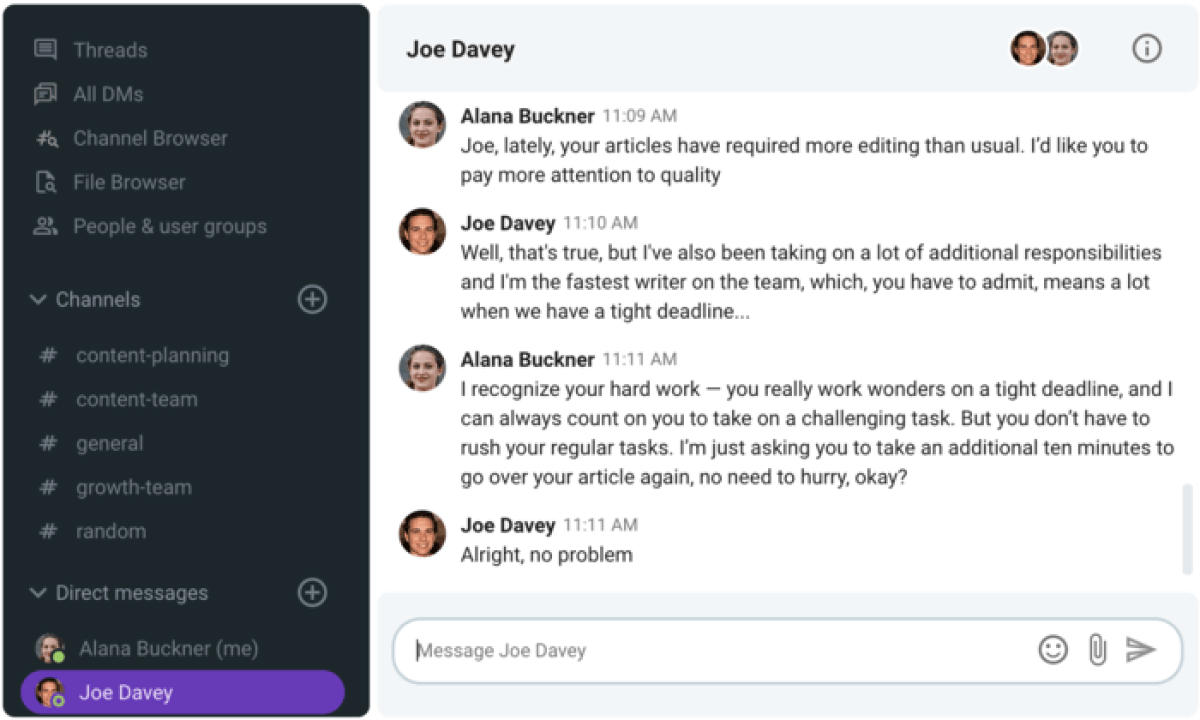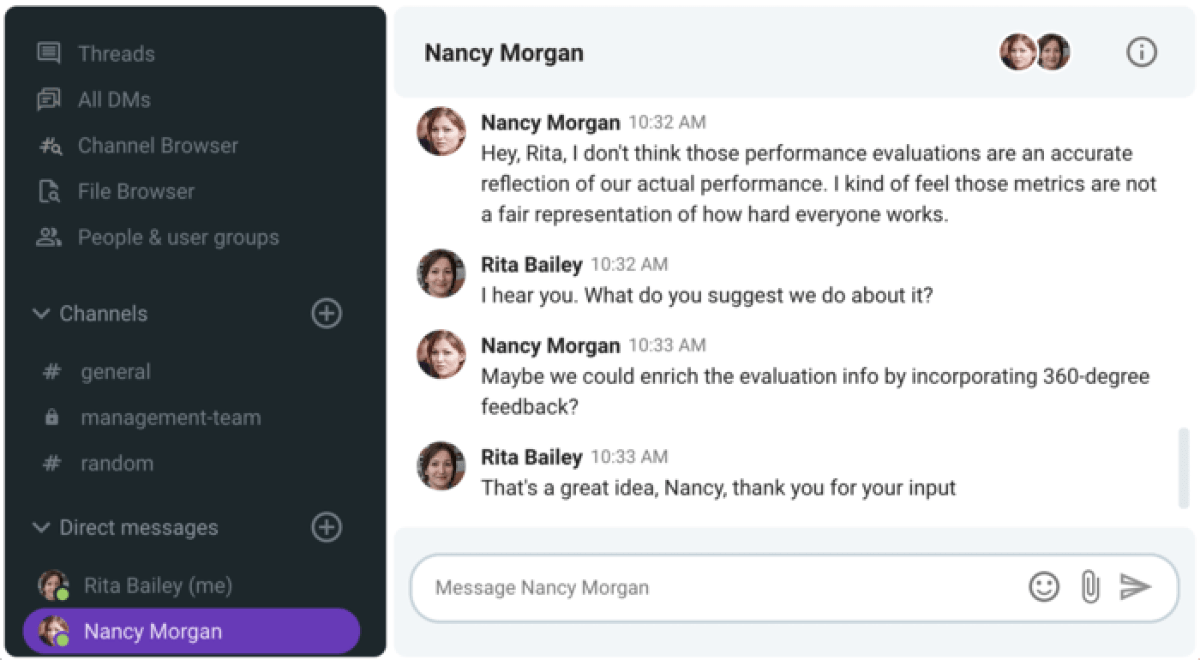In an individualistic workplace culture, employees have more freedom of expression, which improves their self-esteem — and consequently, their mental health, motivation, and overall job performance.
However, when our opinion is against other people’s — especially those operating at higher hierarchical positions — we might hold back from sharing our thoughts in order to prevent others from getting provoked and feeling offended.
Despite the belief “Silence is golden”, keeping opinions to ourselves continuously most likely leads to accumulated frustrations and potential overreactions caused by emotional suppression. Thus, avoiding confrontation can have a long-lasting negative impact on our mental health and business relationships.
To help you improve your business communication and enhance relationships with your colleagues, in this blog post, you’ll learn more about:
- What the main differences between conflicts and disagreements are,
- Why disagreeing respectfully is critical for a healthy work environment,
- How to disagree with your boss and colleagues in a respectful manner, and
- What sentences to use in your next disagreement.
So, let’s dive in!

Table of Contents
What are the main differences between disagreements and conflicts?
What is the first thing that comes to your mind when you hear the word disagreement?
Is it a conflict?
Even though these two concepts are semantically related, they’re not synonymous. While conflicts refer to the collision of ideas, interests, opinions, and needs, disagreement is defined as a difference between the opinions of two or more people.
As definitions already indicate differences between the two of them, let’s dive deeper into the major dissimilarities we need to understand.
Difference #1: Conflicts are more complex than disagreements
According to Harvard Law School, three common types of conflict at the workplace are the following:
- Task conflict (related to work assignments),
- Relationship conflict (caused by personality differences), and
- Value conflict (caused by differences in fundamental values and core beliefs).
Based on the definitions of these categories, we can assume that disagreement equals task conflict, which is the simplest form of conflict.
On the other hand, relationship conflicts are more complex than the former because they occur when personalities, character traits, or work styles are not compatible.
Ultimately, value conflict is the most complex type of conflict since it involves a clash of deeply held values between parties.
Difference #2: Conflicts are long-term, while disagreements are short-term
John Burton, as cited in Conflicts and Disputes, suggests that, unlike short-term disagreements, conflicts are typically long-term due to deep-rooted and seemingly non-negotiable issues.
Namely, short-term disputes are easier to solve by negotiating a compromise. Conflicts, on the other hand, may involve personality and value differences that are seen as non-negotiable.
Difference #3: Conflicts can be internal, disagreements cannot
Internal conflicts involve ambivalent feelings. Ambivalence refers to the state when we have mixed positive and negative feelings about someone or something.
According to the article Understanding ambivalence and inner conflict: “When we are torn between different feelings, we may weigh arguments one way or the other and try to decide on the right course of action, yet after much back and forth, often still can’t decide on an appropriate course of action.”
For instance, we can feel ambivalent about starting a new job — at the same time, we would like to stay in our company where we’ve built healthy relationships with our colleagues, but also would love to find a job with more growth opportunities.
On the other hand, disagreements occur exclusively between two or more people.
Difference #4: Disagreement can turn into conflict
Lack of communication and leaving disputes unresolved lead to conflict.
In other words, disagreements may easily turn into conflicts if you don’t deal with them effectively. Most times, conflicts occur as a result of multiple unresolved disputes.
Thus, despite their unpleasantness, resolving disagreements is vital for maintaining a good relationship with colleagues and reducing conflict risk.
💡 Pumble Pro Tip
To learn more about how to diffuse conflicts with your coworkers, check out our blog post:
Why is disagreeing respectfully important?
Before we dig deeper into the importance of disagreeing in a respectful manner, let’s briefly explain distinct communication styles:
| Passive | Aggressive | Passive-aggressive | Assertive |
|---|---|---|---|
| Avoiding disagreements and conflicts or using indirect language to disagree | – Impulsiveness – Tendency to lose temper – Criticizing – Blaming others – Using obscenities | Acting out aggressiveness in a subtle way (being sarcastic, talking behind back) | Tendency to disagree directly and respectfully |
| Concerned for others’ needs, not your own | Concerned only for your own needs | Being aware of your needs, without voicing them | Concerned for your own needs and other people’s needs |
| Example: Okay, I will take over the project from you. | Example: Can’t you see that I have too much on my plate? No, I’ll not take on the project! | Example: Okay, I’ll do that for you. I optimistically thought that you could do this without my help. | Example: Unfortunately, I won’t be able to fit that into my schedule this month. I suggest changing the due date. What do you think? |
It’s vital to note that assertive communication is a key component of respectful disagreement. This way, you express your ideas with confidence while respecting the feelings and rights of others. Consequently, you maintain a healthy relationship and meet your needs and interests, as well as the interests of the person you’re disagreeing with.
Thus, disagreements can have many positive outcomes, such as fostering a positive work environment and achieving business goals smoothly — so, it’s completely okay to disagree with others, but do so in a respectful manner.
Most importantly, disagreeing respectfully empowers you to deliver your message effectively while standing up for your interests and earning others’ respect simultaneously — your voice is heard without other people’s feelings being hurt.
According to the Harvard Business Review’s article Why we should be disagreeing more at work, aside from improved relationships and better work outcomes, disagreements contribute to:
- Higher job satisfaction,
- A more inclusive work environment, and
- Opportunities to learn by better understanding the perspective of other people.
On the other hand, aggressive and passive-aggressive styles of disagreeing at work will certainly negatively affect the quality of business relationships and the productivity of those involved — and, making matters worse — create a high-stress environment that leads to serious conflict.
💡 Pumble Pro Tip
For a positive work environment, respect is critical for employee satisfaction and overall job performance. Check out our tips for achieving respectful communication with your coworkers:
—
Since we’ve established the importance of disagreeing respectfully with your coworkers, it’s a perfect moment to discuss the opportunities to speak up at work and give you pieces of advice on how to confront your boss and colleagues assertively.
Opportunities to speak up at work
According to An Exploratory Study of Employee Silence: Issues that Employees Don’t Communicate Upward and Why: “The most frequently mentioned reason for remaining silent was the fear of being viewed or labeled negatively, and as a consequence, damaging valued relationships.”
Despite the hesitation to voice their opinion, knowing when to speak up at work may improve organizational performance and establish employee’s influence.
The most common situations to speak up are the following:
Opportunity #1: When you have an idea for improvement
Every leader highly appreciates employee engagement since it can significantly improve employee productivity and job performance.
Aside from increased productivity, research shows that employee engagement is directly correlated with employee satisfaction. Moreover, other studies revealed that engagement is also critical for employee retention.
One of the best ways to demonstrate your engagement is to express your ideas for improvement. So, when you have something innovative to offer to a project, don’t hesitate to share your thoughts!
💡 Pumble Pro Tip
Active communication helps connect remote teams and makes sharing ideas much more effective. To learn more about how to develop your active communication skills, check out our blog post:
Opportunity #2: When you identify an issue with the working process
When you see a problem with a process, it’s a good time to speak up and suggest a change that might work. Aside from presenting your idea, it’s very important to explain why and how to implement it.
Most importantly, never forget to ask your team members what they think about your suggestions.
💡 Pumble Pro Tip
For a detailed look into practices to follow to give constructive feedback in remote teams, take a look at our guide:
Opportunity #3: When you’re dissatisfied with your situation at work
Have you ever dealt with an unrealistic expectation at work in terms of the quantity of work or deadlines? Most often, employee dissatisfaction is primarily caused by this type of problem, especially when they occur multiple times.
In these situations, it’s significantly important not to complain, but to constructively express disagreement and offer a solution.
Opportunity #4: When you don’t agree with feedback
Sometimes, it happens that people get feedback they don’t agree with.
In this case, it’s important not to be defensive. Instead, make sure you:
- Understand it correctly,
- Ask for further explanation, and
- Explain your point of view.

💡 Pumble Pro Tip
Not sure how and when to ask your manager for feedback? Check out our blog post on the topic:
Tips for disagreeing respectfully with your boss
Due to being aware of the hierarchical structure, many employees avoid confronting their bosses by using a predominantly passive communication style.
However, hesitating to disagree with your boss can be detrimental to your mental health and job performance.
To learn how to disagree with someone more powerful assertively, consider the following tips:
Tip #1: Focus on the intention
According to the article How to disagree with your boss: “You can be far more candid about your view if you frame it in the context of a mutual purpose that the boss already cares about. If you fail to do this, the boss may believe your disagreement signals a lack of commitment to her interests.”
Taking into account this statement, make sure that the purpose of disagreement is crystal clear to your boss by more deeply explaining your suggestion.
This way, you ensure your confrontation will not trigger your boss’ defensive reaction.
Tip #2: Choose an appropriate moment
Imagine this situation:
You’ve just finished creating a new Facebook ads report for this month and gained valuable insights that may improve the performance of the upcoming campaigns. You’re super excited and want to share your suggestions for changes with your boss as soon as possible.
However, instead of sharing your thoughts immediately, make sure it’s an appropriate time by asking your boss what time is the most convenient for them to discuss the further strategy.
Tip #3: Keep it impersonal
The crucial difference between disagreeing respectfully and disrespectfully is in making the disagreement impersonal by focusing on the issue rather than the person.
For example, your boss shortened your project deadline due to an increased amount of work.
Instead of saying: “I’m sorry, but I think you gave me too many assignments for next quarter”, say something like this:
“Thank you for putting your trust in me, but I think that will be detrimental to the quality of the project.”
Can you find the main difference between the two?
The first sentence makes disagreement personal by mentioning “you”, while the latter sheds light on the issue and gives the reason that backs up the dispute.

Tip #4: Choose the right words and ask questions
Words always matter!
Choosing inappropriate words leads to miscommunication, which may cost you a good relationship with your boss. Using absolute statements will most likely make disagreement personal — making matters worse — so your boss may perceive you as a threat to his interests.
In addition, make sure to ask questions and check whether you understand your boss’ point of view well before you confront his opinion.
Moreover, paraphrase your boss’ statement to show them that you’re listening actively and recognize their point of view.
This way, you lower their defense mechanism and help them recognize your good intentions.
Most importantly, you make them open up to hear your ideas.
Aside from paraphrasing, try to ask questions like this:
“Could you explain to me your viewpoint in more detail? How are you seeing this problem?”
Tip #5: Offer alternatives
Constructive disagreement always implies offering solutions. By doing so, you take the situation forward and demonstrate your proactivity.
Let’s take an example we’ve already discussed — your boss shortened your project deadline, and you know that would be so stressful and detrimental to the quality of work. You can say something like this:
“Thank you for putting your trust in me. To be honest, my previous experiences have taught me that a change of deadline could be detrimental to the quality of the project.”
This is a good starting point since you state your disagreement and give a reason that supports your opinion by showing concern about your common goal — which is, in this case, the quality of the job. However, if you don’t provide a potential solution, it’s hard to come to an agreement. So, make sure to offer one or more alternatives.
In this situation, you can say something like this:
“I strongly believe we can ensure the quality of work while shortening the deadline by dividing up a project. What do you think about that?”

This way, you provide a solution that meets your common interests and at the same time ask the boss how it sounds to them.
However, make sure to cast off suggestive questions that force the person to confirm your idea, such as “Don’t you think we should divide this project?”
Tips for disagreeing respectfully with your colleagues
Most people tend to avoid disagreements with their colleagues in order to maintain harmony in the workplace.
However, confronting them — politely and assertively — leads to more accomplishment by bringing new ideas to the table and exploring different perspectives.
So, let’s learn how to disagree with coworkers effectively and respectfully.
Tip #1: Make them feel heard
When communicating disagreements with your colleagues, it’s important to make them heard instead of pushing your thoughts on them.
For instance, deep listening is an effective way to show your coworkers that you respect their points of view — most importantly, that you’re willing to hear and consider their opinions.
By doing so, you lower their defense mechanism and make them feel valued and acknowledged.
Tip #2: Agree to disagree
Once you’ve made your coworker feel respected and valued, it’s a good time to agree to disagree.
In other words, understanding that disagreement is a natural and healthy part of collaboration is critical for a healthy work environment.
For this reason, both parties need to agree that they have different points of view, which is completely okay. Moreover, two heads are better than one.

Tip #3: Forget about the “me vs you” mentality
The “me vs you” mindset prevents inclusivity at work, which kills team spirit and weakens relationships. Even if your ideas collide with your coworker’s opinion, you are not on opposite sides — you’re going together towards the common goal.
How to communicate effectively with someone who disagrees with you disrespectfully
Modifying our behavior and improving communication skills is such a powerful way to live happier lives.
But, what to do when someone else gets their point across disrespectfully and behaves aggressively or passive-aggressively?
Unfortunately, we can’t change other people and control their behaviors. However, the good news is that we can set boundaries and control our responses in order to communicate effectively.
Next time your coworker shows disrespect to you, here are some examples of what to say:
“Unless you talk to me with respect, I won’t be willing to hear your opinion.”
“I understand that you disagree with me, but it’s not okay to yell at me.”
“I understand that you’re being sarcastic, but I’m not okay with that.”
“I don’t want to put up with your behavior. I suggest discussing the issue when you feel less upset.”
💡 Pumble Pro Tip
Communication with difficult people may be very challenging and exhausting. To learn how to deal with difficult coworkers, check out our blog post:
Wrapping Up: Let’s agree to disagree (respectfully)
All things considered, we can note that disagreements are a healthy part of business communication and collaboration with multiple positive outcomes on organizational goals and employee satisfaction. Whoever you’re disagreeing with at the workplace, the way you express your thoughts matters more than what is being said.
For this reason, show that you respect others’ points of view and that you’re committed to your common interests — also, choose the words wisely, ask questions and listen deeply.
Respectful disagreement is assertive, impersonal, and constructive — most importantly, it implies a good intention that meets the interests of the parties involved.
Taking this approach leads to a collaborative culture, healthy professional relationships, and better mental health.





